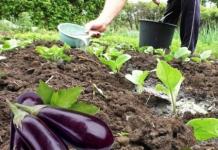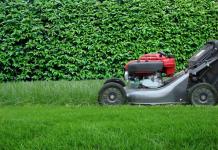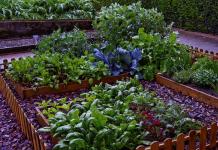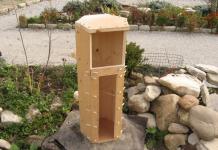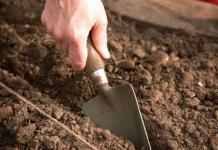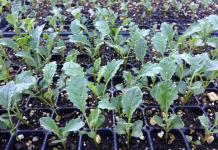Carrots are a very necessary vegetable in the kitchen! All year round we add it to hot dishes, eat it fresh and mix salads. The cost of carrots in the store is low, so maybe it would be more convenient to just buy root crops as needed, without spending time growing it? However, closer to spring, store-bought carrots begin to rise in price significantly, their quality deteriorates noticeably, and those who do not stock up on time have a hard time.
That is why in every garden there is a garden bed for this beloved vegetable crop, and experienced gardeners exchange experience with beginners on how to properly plant carrots in order to get a rich harvest of healthy root crops.

If you have not had to grow vegetables before, and you have no idea how to plant carrots, or you can’t grow normal tasty root crops, our article will definitely be useful to you. We will talk about how to plant carrots with seeds, how to care for young shoots, and how to protect the garden from.
Video about preparing carrot seeds for planting
Depending on the variety of seeds you bought, the timing of their sowing will also vary. So, in the twentieth of April, you can start sowing early-ripening varieties, from April 25 to May 5, mid-ripening varieties begin to be sown, and carrots intended for winter storage are planted on June 10-15.
Under the carrot bed, it is recommended to choose a site where there are not too many weeds, since the weeds will sprout before the carrots and prevent it from growing. The soil should be loose, preferably with sand content. In heavy soil, root crops can turn out to be curved, clumsy, small. If there is a constantly elevated level of moisture in the soil, the roots will rot, and in dry soil the carrot will turn out to be “wooden”.
Consider also after which crops you will sow carrots. It is best to choose those areas where cucumbers, tomatoes, garlic, onions, cabbage, potatoes or greens (except lettuce) grew last year. After parsley, it is better not to plant carrots, as pests that are dangerous for carrots can remain in the soil.

In heavy soil, root crops can turn out to be curved, clumsy, small
Dig up the soil in the garden in the fall, and in the spring, walk along the ground with a flat cutter. Additionally, you should not dig up - settled earth is preferable for carrots. Most importantly, do not add fresh manure to the soil, as carrots do not tolerate its acid. The bed can be fertilized with mineral fertilizers a couple of weeks before planting carrots.
Planting carrots is done by seeds immediately in open ground. Prepare seeds in advance:
- soak for two hours in clean water at room temperature;
- scatter the seeds over a damp cloth and cover with another damp cloth on top;
- keep the seeds in the room, periodically stirring them gently;
- soak the fabric when dry;
- when the seeds are completely swollen and begin to hatch, move them to the refrigerator for 10 days for hardening.
Simple and accessible on how to properly plant carrots

It is enough to maintain a distance between the seeds of 1.5 cm
Sprinkle the bed reserved for carrots with ash, cut it through each groove up to 2.5 cm deep, leaving row spacing of 20 cm, and 12 cm along the edges of the ridge. Pour the grooves with water and sow the prepared seeds. It is enough to maintain a distance between the seeds of 1.5 cm. Level the furrows with earth. Above the bed at a height of 15 cm, it is recommended to stretch the film so that shoots appear faster, and with the advent of greenery, the film can be removed.
Experienced gardeners, in an effort to simplify the process of sowing seeds, sometimes come up with quite unusual methods how to plant carrots: someone mixes the seed with sand before sowing, while others pre-paste one seed at a time on tapes of thin paper (you can use toilet paper). A carrot seed is picked up with a toothpick, dipped in paper glue or paste and applied every 5 cm to paper. Such paper tapes are laid in the furrows and sprinkled on top of the earth.
Video about growing carrots
Plant a radish along the edges of the bed, it will sprout pretty quickly, marking the rows of carrots, and you can start loosening the row spacing early (carrots love frequent loosening). It is also very useful to plant onions on a carrot bed, as its smell drives away carrot flies, the most dangerous pest of carrots.
At first, the bed should be watered abundantly, and when the first shoots turn green, reduce watering to twice a week. Although not all of the seed material will sprout, the seedlings will still need to be thinned out after the formation of the first leaf, leaving the strongest plants.
Despite the seeming simplicity, growing carrots in a garden plot is a very responsible process and requires a certain amount of knowledge, skills and abilities. Of particular importance is the preparation of beds for carrots in the spring. Experienced gardeners start planting carrots in mid-April or early May (depending on the region). The optimal period is when the daytime air temperature ceases to fall below + 10-12 degrees, and at night - below +5 degrees. On the beds sown at this time, the crop will ripen in July.
What should be the soil
Preparing a bed for carrots in spring
Before planting a crop, you should understand what kind of soil carrots love. Practice shows that each carrot variety, without exception, to such a condition as soil, is very demanding. Firstly, the earth should not contain anything superfluous: no pebbles, no roots, no solid debris. Under no circumstances should the soil be acidified. The acidity index should not go beyond the normal range. If the earth is clayey, or planting is carried out in black soil, it is recommended to add sand to the composition of the soil for carrots at the rate of 1 kilogram per 1 square meter of beds. If the soil is too sandy, humus, manure or potato skins will come to the rescue. Nevertheless, it is the sandy soil for carrots that is considered to be more preferable. This is due to the high breathability of sand and its unique ability to absorb moisture.
Important! Carrots grow more even if they grow in loose soil. In hard ground, crooked and deformed root crops often ripen.
When choosing soil for carrots, you should pay attention, first of all, to sunny areas. No crop variety will give an extensive harvest if planted in the shade. The following are also expressly excluded:
- soil with a high dryness index;
- inclined areas;
- areas overgrown with weeds.
Generally speaking, the optimal soil for carrots in the open field should be excellent in oxygen and moisture, free from weeds and root residues of other plants, and rich in nutrients.
How to prepare a garden
After choosing the soil, it's time to find the answer to the question of how to properly prepare a bed for carrots in the spring. The process of preparing the soil for planting carrots begins with a mandatory check of the site for its ability to pass moisture. To do this, you need to do the following: pour about 8 liters of water onto the soil that has not yet been dug up for carrots measuring 50x70 centimeters. If an hour after watering spots are visible on the surface, then the soil is unsatisfactory (too dry and with a high acidity index), and the carrot will most likely not take root in it. If there is no spot, and the condition of the earth is such that you can make a lump out of it without any extra effort, then everything is in order, and you can start sowing crops without hesitation.
Having figured out what kind of land carrots love, it's time to start spring work in the open field. It is most expedient to do this just half a month before the start of planting work. First you need to remove all the weeds from the garden and leave it to "rest" for a couple of weeks. Then the site will need to be dug up two, and even better three times, while saturating it with useful substances. Pebbles in the process of digging should be removed, and earthen clods should be broken.
If the soil is poor enough, it requires fertilizing with humus and careful additional digging, despite the fact that experts recommend fertilizing with organic fertilizers in the autumn.
Advice. With each application of fertilizer, the earth must be dug up. This is necessary so that useful substances and trace elements are at a depth of at least 15 centimeters. Otherwise, they can burn the root system of plants.
Fertilizing the soil
The main answer to the question of what kind of soil is needed for the successful cultivation of carrots refers us to the fertility indicator. Accordingly, fertilizing the soil is one of the necessary steps towards obtaining a good harvest.
As already mentioned, organic matter is best applied in the autumn, after harvest. But mineral fertilizers in the spring will be as appropriate as possible. The correct feeding time is two weeks before planting seeds in the garden. At the same time, it is very important that the technology for preparing the fertilizer composition is observed (as a rule, all the necessary instructions are available on the fertilizer’s factory packaging).
If crops are grown in small volumes for personal use, it is quite acceptable to limit yourself to organic. In this case, ordinary humus or manure is suitable.
In the spring, it is allowed to treat the soil with fertilizers based on nitrogen, potassium and phosphorus. All of the above is chemistry, but it has a positive effect on the growth of carrots. If the soil is acidic, it must be further treated with any alkaline component, such as lime. After such treatment, the acidity of the soil quickly normalizes. As with growing onions, carrots should not be overdone with manure. Otherwise, you can forget about the garden with carrots, at least for a couple of years.
How to land
Usually the width of the beds is made from 90 to 100 cm, and the height - from 15 to 20 cm.
Everyone who has grown onions at least once will also cope with planting carrots without problems. In addition, making a bed for carrots is not particularly difficult. The most important thing to do is to calculate the correct size and prepare the ground for carrots in advance.
Usually, the width of the beds is made from 90 to 100 cm, and the height is from 15 to 20 cm. If groundwater is close to the planting site, it is strongly recommended to increase the height of the bed to 35 centimeters (to its lower border). The length can be completely arbitrary, it all depends on the wishes and needs of the gardener, as well as the size of the plot. You will definitely need to make a wooden side, which will prevent water from running off and blurring the beds during irrigation.
To place the seeds, it is necessary to form special grooves, the depth of which will not exceed three centimeters. Be sure to observe a gap of 20 centimeters between them. As for the distance between root crops, it can vary from two to four centimeters.
Important! The seed furrow should never be too shallow or too deep. In the first case, it is highly likely that the seeds will be blown away by a gust of wind, and in the second, that they simply will not be able to break through the thickness of the earth to the surface.
Ideally, you should sow the seeds in such a way that later you do not have to deal with thinning. It is quite difficult to achieve this, but you should still try. Indeed, otherwise, the smell of tops when pulling out a root crop from the ground will inevitably attract the attention of such a harmful insect as a carrot fly.
Immediately before sowing carrot seeds, each groove must be thoroughly moistened. Since carrot planting material is very light, it is not uncommon to mix it with sand for convenience. In those places where the seeds are too thick, experts recommend spreading the contents of the groove with a brush.
After planting the seeds is completed, sprinkle the groove with mulch:
- humus;
- biohumus;
- compost;
- coconut substrate.
After the sprouts hatch through the mulch, it must be removed, and the seedlings should be watered.
Important! Until seedlings appear, it is not recommended to water the sowing site in order to avoid blurring the seeds.
Carrot growth is quite slow, in addition, as already mentioned, it does not like excess moisture. If you organize beds-ridges, raising the site for planting by 30-35 centimeters, the problem can be solved. If the soil dries well, simple grooves are sufficient.
Before planting, the seeds should be soaked, and after planting and abundant watering, cover with plastic wrap. This step is necessary in order to save the heat and moisture necessary for seed germination in the soil. If all manipulations are performed correctly, the first shoots will appear in less than a week. It is very important not to forget to remove the film after the very first shoots appear.
Planting in narrow beds
Planting in narrow beds
In recent years, the method of planting carrots in narrow beds, also known as the Jacob Mittlider method, has been very popular among gardeners. Such beds have a significant difference from the standard options. They are characterized by high side walls and relatively wide aisles. The task of narrow and high beds is to protect the sown carrots from weeds and winds in the most reliable way. In addition, purely visually, such a bed looks just perfect.
To equip a narrow bed you will need:
- two containers that will be used for mixing fertilizers;
- narrow rake (no more than 30 centimeters wide in the area of the working part);
- wooden pegs;
- hoe;
- shovel;
- wooden boards for the manufacture of sides.
The algorithm of actions in this case will be approximately as follows:
- Mark the beds and use pegs to mark their boundaries. The optimal width of the beds will be no more than 45-50 centimeters, the length can be any (usually gardeners choose in the range from 3 to 9 meters);
- Make wide enough (about 1 meter) passages between the beds;
- Pin wooden boards around the perimeter. The height of the resulting sides should be 10 centimeters, and the width - 5 centimeters;
- Fill the paths between the beds with gravel or carefully compact in such a way as to reduce the likelihood of weed growth and the appearance of moles to zero.
Important! It will be best to place a narrow bed in the direction from the east side to the west. This will enable carrots to receive the necessary amount of sunlight in a constant mode.
Proper use of narrow beds allows you to get a much larger yield (about twice) than using standard planting methods.
Secrets of experienced gardeners
Properly prepare the soil, build a garden bed and, as a result, grow an excellent harvest of carrots will help the advice of experienced gardeners who have been cultivating this crop for several years and have managed to achieve some success in this field. Consider the most interesting recommendations in more detail:
- If you grow carrots after cucumbers, you will need to add at least one and a half kilograms of cow manure and 5 kilograms of crushed corn leaves for every square meter of beds. When growing carrots on black soil, it will be necessary to add potato husks and river sand to the indicated one - 1 kilogram per square meter of planting;
- It is important to track and remember how previous crops grew in the selected area. So, for example, if cabbage grew there before carrots, and the harvest did not please, the likelihood that a similar story would happen with carrots is quite high. Abundant top dressing with mineral and organic fertilizers will help to correct the situation;
- If the tomatoes grown earlier on the plot for carrots turned black during the growth process, planting carrot seeds does not make sense. It is better to sow the area with parsley or beets;
- To get rid of the carrot fly, it will be useful to plant carrots as early as possible and in the same bed as onions. Such a move would prove beneficial to both cultures;
- For even distribution of seeds, it is more efficient to mix not with sand, but with a clover. If a certain amount of mineral fertilizers is added to the latter, the benefits (and, accordingly, germination) will be much higher. It is most convenient to place such a mixture in the grooves using a confectionery syringe;
- Too wet soil will promote the occurrence of carrot diseases. Therefore, stagnant water on the site should be avoided by all means;
- If the farm has a sufficiently large amount of compost and physical strength, it is possible to prepare beds for carrots in a fundamentally different way: a trench is dug at least 30 centimeters deep, filled with compost mixed with fine river sand, and seeds are poured into this fertilized soil.
Despite the fact that carrots are an integral part of the daily diet of a large number of our compatriots, growing them with your own hands is not as easy as it might seem at first glance. But if you prepare the garden bed properly, avoid mistakes when sowing seeds and provide the crop with proper care, a decent harvest will not keep you waiting.
Potatoes are usually commercially grown using industrial methods using mineral fertilizers and pesticides. Real gardeners will never buy such a product, but they will try and grow excellent carrots in their own garden plot. If you strictly follow the recommendations given, there should be no problems with cultivating the culture.
Video
A bed for carrots for spring sowing, it is recommended to cook from autumn. Comfortable bed size for growing carrots:
– width 90 cm,
- height 15-20 cm.
In autumn, the soil in the garden bed for carrots should be dug up, leveled and fertilized.
Fertilizing the soil in autumn
A bed for planting carrots in spring, as mentioned earlier, form in the fall. Application of mineral and organic fertilizers under the carrot(immediately before planting) does not have the best effect on root crops.
It is categorically impossible to bring fresh manure under carrots in spring. When introducing manure into the soil, it is recommended to plant carrots in this place only after 2 years. It is recommended to grow carrots as the 2nd crop after applying manure (after growing cucumbers, onions, early cabbage, early potatoes in this place).
earth in autumn it is necessary to dig (depth is at least 20, optimally 30-40 cm), choose pebbles, and even better - sift. Carrot loves loose soil, and if it encounters obstacles during active growth, it curves and forks.
Carrots will love it garden bed from a mixture of peat (sawdust or needles) and sand, which also needs to be sieved. For one bucket of peat, take half a bucket of sifted sand and a 1-liter jar of ash. On such a bed, a vegetable can grow 3-4 years. The advantages of soil prepared specifically for carrots are that it does not contain weed seeds and is perfectly saturated with oxygen, which is so necessary for the formation of quality root crops. To feed such soil, it is required to apply chlorine-free potassium in the spring during pre-sowing soil preparation in the amount of 1/2 cup per 1 linear meter.
In the reference book "Garden. Practical advice" recommend:
- fertilize nutrient-poor soil in autumn for digging 3-4 kg per 1 sq.m of humus;
- harrow 2-3 cups per 1m2 of wood ash.
In autumn, acidic soil is enriched with dolomite flour at the rate of 20-30 g per 1 m2. In the spring, as soon as the earth has dried up, it is disinfected with a solution of copper sulfate at the rate of 1 tbsp. spoon on a 10-liter bucket of water and dig. It is convenient to spray the product from a watering can with a strainer nozzle.
How to fertilize carrots in the spring when planting in the garden?
Spring preparation of the soil for planting seeds It is recommended to start 10-12 days before sowing. If the soil is very depleted, it is permissible to add humus (but it is better to do this in the fall) and dig deep.
Fertilize carrots before planting in open ground(in the spring, a week before planting) can be in small doses:
- nitrogen fertilizers at the rate of 10-20 g per 1 m2;
- phosphate and potash fertilizers at the rate of 30-40 g per 1 m2;
- lime at the rate of 300-500 g per 1 m2 (for acidic soils);
- complex mineral fertilizers - nitroammophoska or nitrophoska at the rate of 2 tbsp. spoons per 1 m2.
After applying mineral fertilizers in the spring, the earth is dug up so that the substances are at a depth of 15 cm (so they will not burn the roots of the plant). After digging, the soil in the garden for carrots is leveled with a rake, beds are formed.
For planting seeds, grooves are formed with a depth of 1.5 - 3 cm. The distance between the grooves is 20 cm. The distance between the seeds is 2-4 cm.
Watch the depth of the grooves: if they are too deep, the seeds will not germinate; too small - the seeds will be dispelled by the wind.
During growth, carrots are fertilized separately.
Sources: country literature, reference books for gardeners and gardeners, the Internet
Soil preparation for carrots
If you want to grow a crop of carrots on your site that will delight you, then you need to know that soil for carrots it plays a key role in this matter. Carrots give a high yield only on loose loamy and sandy soils with a neutral or slightly acidic reaction. Clay soils, drying up, form a dense crust, which will subsequently prevent the germination of seeds. As a result, seedlings will turn out to be uneven and sparse.
The soil for planting carrots should contain a lot of organic matter (humus) and have good drainage, should not be very heavy. But you need to know that fresh manure and an excessive amount of mineral fertilizers cannot be added to it, as this will adversely affect the growth and development of root crops. An excess of organic and mineral fertilizers can be the cause of clumsy and "horned" carrots, and this will also contribute to the appearance of its worst enemy, the carrot fly, on the plantings.
When to Apply Organic Fertilizers
Organic fertilizers are applied no later than a year before growing carrots.
What should be the predecessors
The best predecessors are considered to be onions, cucumbers, potatoes, under which manure was applied. After their cultivation, a lot of decomposed organic matter remains, which are easily accessible for carrot seedlings. In addition, the soil after these plants is usually clean of weeds.
This is important because weeds in the initial period overtake carrots in growth and oppress it. In nutrient-poor areas, rotted manure and wood ash are introduced before digging. On fertile soils - only a small amount of mineral fertilizers.
What needs to be applied to the soil
If the soil is peat, coarse-grained river sand, soddy soil, rotted manure are introduced. If the soil is clayey, coarse-grained river sand, humus, small sawdust, peat are introduced. If the soil is sandy, soddy soil, peat, humus, sawdust are introduced. In addition to complex mineral fertilizer is also applied to these soils. If the soil is chernozem, fertile, sawdust and coarse-grained river sand and superphosphate are added. Carrots can be returned to their old place no earlier than after 4 years. This will serve as a good prevention of the development of diseases.
How to prepare a garden
A bed intended for carrots needs to be dug up to the depth of a bayonet shovel in the fall. If the soil is acidic, then 100 g of dolomite flour or chalk is added per 1 m2 before digging, and organic and mineral fertilizers are applied in the spring. In the spring, 2-3 days before sowing, dig bed to a depth of 25 - 30 cm, level the surface of the soil and compact, then spill it with water and cover with a film. Before sowing, loosen the bed to a depth of 1 - 2 cm, make grooves at a distance of 20 cm from each other. Spill them with water or a solution of potassium permanganate and evenly scatter the seeds. Mulch the grooves with peat and cover with a film so that there is a distance of 15 cm between it and the bed. After this method of sowing, seedlings should appear in 7 to 10 days. After the seeds have germinated, remove the film.
Light requirements
When choosing a place to plant, it is important to remember that carrots are light-loving crops. When planting it in a shaded place, you will not wait for a good harvest. The yield in this case, even if all other conditions are met, is reduced by 2 to 3 times. Read a separate article on the site about “How to grow carrots”.
How to sow carrots and care for them
Carrots are grown in a seedless way. At the same time, the terms of its sowing in open ground are as follows:
- in winter: 2nd half of October - 1st decade of November; in spring: 3rd decade in April - 1st decade in May and 1st decade in June.
Scheme of joint cultivation of carrots and marjoram Carrot seeds are small, which makes it quite difficult to sow them. In order to prevent thickening of crops, a little trick is used.
A teaspoon without a slide of seeds is mixed with a glass of sand and 10 square meters are sown with this mixture. m. Carrots grow better in narrow beds, on which there are no more than 4 stripes. If it is planned to grow only carrots in the garden, the sowing technology is as follows.
Before spring sowing, grooves are cut on a previously prepared ridge. The distance between them for medium and early varieties is 15 cm, for late ones? 20 cm. The grooves are watered.
In colder climatic zones, hot water heated to + 50 ° C is used for this. Then the beds are powdered with ash and the prepared seeds are sown on them at a distance of 1.5-2 cm. The sowing depth and the condition of the seeds depend on the season: Swollen seeds are used for summer and spring crops.
They are planted to a soil depth of 3-4 cm. After sowing, the grooves are carefully sprinkled with soil and mulch (humus or peat).
After sowing, the beds are covered with a film, which is raised on bricks by about 5 cm. Before winter, seeds of early varieties of carrots are sown to a depth of about 2 cm. They must be dry, and the thickness of the mulch layer is 3-4 cm. Before winter, carrots are sown when the temperature in the soil drops below +5°C.
If the winters are not snowy, the beds with crops are additionally covered with snow, with a layer thickness of 40-50 cm. This technology allows you to harvest 14-20 days earlier.
Carrot care requires the following conditions
- temperature regime;
For germination of carrot seeds, a temperature of + 3 ... + 5 ° С is sufficient. The air temperature + 20 ... + 22 ° С is considered optimal for normal growth and the formation of high-quality root crops. At the same time, carrots are resistant to cold, their shoots are able to withstand frosts down to -3-4 ° C and die only when the temperature stays below -6 ° C for a long time. The tops of mature plants die when the temperature is below -8°C.
- watering mode;
The volume and frequency of watering directly depend on weather conditions and the age of the plants. Basically, carrots need to be watered once every 7 days according to the following scheme: Tentative scheme for sowing carrots on drip irrigation.
- 3 liters of water per 1 sq. m of land at the very beginning of the growing season. 10 liters per 1 sq. m after secondary thinning. 20 liters per 1 sq. m during the period of growth of root crops.
When approximately 2 months remain before harvesting, it is necessary to water once every 10-14 days 10 liters of water per 1 sq. m of soil. When 2-3 weeks remain before harvesting the root crops, watering is stopped. When growing, it is necessary to monitor the soil moisture.
The soil should not have both excess and lack of moisture. Carrots, even for a short time, do not tolerate excessive moisture, which causes rotting of root crops, and with prolonged drought, its root crops stop developing, which negatively affects the quality of the crop.
- weeding;
Carrots sprout slowly, and the beds with it quickly sprout with weeds. To avoid the growth of weeds that inhibit the development of carrot shoots, they must be disposed of.
The first time carrots are weeded 10-12 days after the first true leaf appears on the plant. The second - 8-10 days after the next true leaf appears. Weeding is combined with loosening the soil and thinning seedlings and is carried out after heavy rain or another watering.
- top dressing;
3-4 weeks after the seeds have hatched and the first shoots have appeared, the plants are fed for the first time with an aqueous solution of chicken manure, mullein, humus or ash (1:10). If necessary, during the formation of root crops and plant growth, feeding is repeated.
In areas where organic farming is practiced, due to which a layer of humus is formed in the soil, top dressing is not necessary. To avoid thickening, carrots are thinned out twice: 11-12 and 19-20 days after the first shoots appear. After the first thinning, the interval between adjacent shoots should be approximately 3 cm, after the next thinning - 5 cm.
This procedure is best done in the morning, after its completion, the bed must be watered. Experienced gardeners cultivate the soil on which carrots grow with ground red pepper (hot, hot or bitter).
This will muffle the smell characteristic of carrots and protect them from carrot flies. Another effective way to protect against this pest? combined planting of carrots and onions. Mulching should not be neglected, which significantly saves the effort and time needed to get a good harvest.
Back to index
What affects the quality and quantity of the carrot crop
To get good healthy carrot roots, you need to follow the agricultural technology of this garden crop. The quality of the crop during its growth is influenced by many factors. Here are some of them:
- with a lack of light, carrots produce small root crops; root crops cannot develop normally on dense, stony and heavy clay soils. On such soils, they acquire an ugly shape and have a rough taste; carrots growing on acidic soils are not sweet enough; too rare crops and excessive moisture lead to increased growth of root crops, which coarsen and deform. Therefore, it is not worth chasing too large carrots; with insufficient watering, carrots lose their juiciness and coarsen; with prolonged rains or excessive watering, carrot roots crack and deform; damage to plant roots during thinning and the introduction of fresh manure into the soil leads to branching and distortion of root crops.
https://www.youtube.com/watch?v=YaBUvKFUF2UGrowing carrots in your garden is not particularly difficult. The main thing is to follow the above rules, create conditions in order to avoid factors that negatively affect the quality of its growth, and you will have every chance for the crop you grow to consist of beautiful, juicy and sweet sunny root crops.
Site preparation for carrots
Author: Valery | Rubric: carrots | 2012-10-10
When growing carrots, preparing the beds is of great importance to obtain rich harvests.
When growing carrots, one must remember that - this crop is demanding on the composition of the soil. Good yields of carrots can be obtained on light and medium loamy soils, or on cultivated peat lands with pH = 7.0 (neutral), weed-free, well-drained.
Fresh manure is not introduced into the soil under carrots. Carrots grow well on lands where their predecessors grew last year - cabbage, greens and legumes, potatoes, tomatoes. Under carrots, it is better to dig a bed from autumn to the depth of a bayonet shovel and leave it until spring.
In this case, lumps do not need to be broken. So it will freeze better and in the spring there will be no such lumps, the frozen moisture will break them into small particles.
If you have acidic soil, then before digging, add one glass of dolomite flour, fluff lime or chalk for each square meter of beds. A bed for planting carrots is prepared 2-3 days before sowing.
Depending on the composition and fertility of the soil, organic and mineral fertilizers are applied in the spring. For each square meter of beds with peat soils, add 5 kg of coarse-grained river sand, 3-5 kg of manure humus, one bucket of soddy soil (clay or loamy).
Mineral fertilizers are also added: one teaspoon of sodium nitrate or urea (carbomide), one tablespoon of powdered superphosphate and potassium chloride or potassium sulfate. Then, after adding all these components, the bed is dug up to a depth of 20-25 cm (because the main varieties of carrots have long roots).
The bed is well developed, the surface is leveled and compacted. After that, the ridge is watered with such a solution: one teaspoon (at the level) of copper sulphate and one glass of mushy mullein are diluted in a bucket of warm water, mixed well and watered at the rate of two liters per square meter of beds.
Then, in order to avoid evaporation of moisture and to preserve heat, the bed is covered with plastic wrap. On clay and podzolic soils, 1-2 buckets of peat and coarse-grained sand, one bucket of humus, half a bucket (3-5 kg) of small (processed) sawdust (preferably not fresh, rotted) are added for each square meter of beds.
Mineral fertilizers: apply crushed superphosphate - one tablespoon and nitrophoska - two tablespoons. In the spring it is necessary to carry out liming with chalk or dolomite flour, if you did not do it in the fall (which is preferable): two or three tablespoons for each square. m. With light loamy soils (they consist of clay and sand) - they produce fertilizer in the same way as clay soils, but do not add sand.
On sandy soils, two buckets of peat, soddy soil and one bucket of processed sawdust and humus are added. From mineral fertilizers, the same ones are applied as for clay soils.
If granular fertilizers are used, then they do not need to be ground into powder. On chernozem fertile soils, add half a bucket of small old or fresh processed sawdust and a bucket of sand.
Mineral fertilizers: add two tablespoons of superphosphate, crushed into powder. Manure humus can be replaced with compost, but it should not contain weed seeds. 3-4 days before adding sawdust to the soil, they must be processed.
This is done in this way: 5 buckets of fresh sawdust are poured onto a piece of film laid out on the ground. Five tablespoons of nitrogen fertilizer (ammonium sulfate or urea) are diluted in a bucket of hot water, poured into a watering can and sawdust is slowly shed with this solution.
Sawdust will be ready for use in the garden the faster, the higher the temperature of the solution (40-50 ° C). Fresh sawdust, untreated in this way, can only be applied to the beds in the fall.
If fresh sawdust is introduced in the spring, then the leaves of carrot seedlings will have a pale color due to a lack of nitrogen (sawdust takes nitrogen from the soil during decay). When planting carrots on newly developed lands (virgin lands), it is necessary to carefully select all rhizomes, especially wheatgrass, as well as wireworm larvae and May beetle, when digging.
On these soils, in the first year of planting, the carrot harvest is usually good without additional fertilizers. Carrots, like all vegetables, are a light-loving culture, so in the shade, root crops grow very short (up to 3-5 cm), and the yield is reduced by two to three times.
Excessive moisture in the soil contributes to diseases of the roots of carrots, therefore, in places where groundwater is close, the beds should be made at least 30-35 cm high. On poorly cultivated and dense soils, root crops grow in an ugly shape, branch out, and the quality of root crops and yield decrease.
"Carrots on undigged soil. And ... how not to dig the earth" (part 4)
Sowing dates are of decisive importance for the carrot harvest. Since carrot seeds germinate slowly, they require good soil moisture and should be sown as early as possible while there is enough spring moisture in the ground.
If you are late with sowing, then the seeds will fall into dry soil and as a result, rare, weak seedlings will germinate, and often the seeds will not germinate at all and you have to finish the bed. For sowing seeds of carrots, the most optimal terms are: in the central and middle lane: early varieties - from April 20 to 25; mid-season - from April 25 to May 5.
In the southern regions, sowing is carried out in two terms: for obtaining products in the summer, spring - March 10-20, and for obtaining seed plants (uterine roots) and winter consumption, summer sowing - June 10-15. You can sow carrots before winter, on frozen soil, in November-December.
Sowing is done with dry seeds so that they cannot germinate until spring, otherwise the seedlings will freeze. Such carrots, podzimnogo sowing, grows much earlier, but it is used mainly in the summer, because. unsuitable for storage.
So having prepared the soil for growing carrots, you will get a rich harvest.
I wish you excellent, guaranteed harvests in any weather!
- Video: seminar on growing carrots and other root crops
Carrots are a vegetable that can be found in gardens all over the world. Root vegetables contain a lot of useful substances, such as carotenoids, phytoenes, lycopene, pantothenic and ascorbic acids, essential oils.
Growing carrots in a summer cottage will ensure the supply of vitamins to the table all year round. This crop is unpretentious, but requires compliance with agricultural technology, otherwise the crop will not be of the highest quality. Carrots need light, they cannot stand shading, but at the same time, they tolerate frost well., and continues to grow even at low positive temperatures.
Where to plant?
The technology for growing carrots involves placing them in beds with good sunlight. In shaded places, thin, hard, and completely tasteless root crops grow.
Carrots are grown mainly in open ground, covering plantings with a film in early spring to protect them from frost. This vegetable belongs to the umbrella family, or celery, therefore after parsley, parsnip, celery, dill, cumin, anise and fennel, carrots cannot be planted, in the ground, pests that have settled there since last season, hungry after hibernation, can wait for it. The best predecessor for carrots is potatoes, after which the soil remains loose.
This sequence provides normal conditions for the formation of even large root crops, they do not branch or bend, but have a harmonious shape of an elongated cylinder. There are practically no common diseases in these crops (the exception is wireworm), but to protect against it, you can plant calendula officinalis (marigolds) around the beds. The next year, after using the beds for carrots, legumes are planted in its place.
What varieties to choose?
The choice of variety depends on what goals the gardener sets for himself. If you need fresh carrots for summer consumption, it is best to plant the Vitamin-6 variety. It grows quickly, has a pleasant taste and high juiciness, but it is difficult to store.
Therefore, for stocks for the winter, root crops with an average length of the growing season are planted, for example, Losinoostrovskaya -13, Nantes (without a core). For winter storage, late-ripening carrots are excellent, for example, Queen of Autumn, Moscow Winter, Incomparable, Golden Autumn. Often the choice of variety depends on the structure of the soil.
The technology for growing carrots involves the use of loose, sandy soils rich in organic matter. If the site has heavy alumina or chernozem, it is best to use short-fruited varieties - Karotinka, Parisian Karotel and Parmeks.
How to prepare a garden bed?
Each gardener has his own secrets on how to prepare a bed for carrots. For example, some two weeks before the proposed planting, the ground is covered with a film in order to create comfortable conditions for the growth of ... weeds !!!
There is a logic in this - everything superfluous can be removed immediately, and carrots can be planted already in relatively clean soil. After harvesting weeds, the soil is dug up to the depth of a shovel bayonet, loosening it as much as possible. If the soil structure is very heavy, then it makes sense to add sand to improve its structure.
By the way, for the same purpose, you can make crushed eggshells, it decomposes poorly, and serves as a baking powder for the soil for many years. Organic fertilizers are applied - humus or well-rotted compost. The acidic reaction must be neutralized with chalk, dolomite flour or ash.
Carrots have such features - it does not pick up sweetness on such soils, root crops turn out to be tasteless. If organic matter is not used, and the land is obviously poor (depleted by intensive farming), mineral fertilizers are applied to it.
To “refuel” the soil, either complex mineral fertilizers are used - ammophoska, azophoska (in accordance with the instructions for use), or a mixture of nitrogen and phosphorus fertilizers (potassium is applied later, in the form of liquid root dressing). You can also go in an alternative way, using modern innovation. For example, a few weeks before planting carrots in open ground, add vermicompost to it, and a few days to cultivate the land with humates.
Landing methods
- Seeds. This is the easiest way, but also the most economical one. A handful of seeds are poured into the grooves. Seedlings with such agricultural technology are uneven, they have to be thinned out. Dragee. Seeds enclosed in a bright shell of useful macro- and microelements are the most convenient for planting. Even though they are more expensive than simple ones, they are often more profitable. From the seeds in the shell, very strong and friendly shoots are obtained. Accordingly, they are required many times less, since they are easy to plant pointwise, without subsequent thinning. Soaked and germinated seeds. With this method, seedlings appear much earlier, but the bed will have to be watered all the time, otherwise the sprouts will not have enough strength to break through the thickness of the earth. Paper strips with glued seeds. You can buy them ready-made or make your own from toilet paper and paste. The biggest plus of this method of growing carrots is the uniformity of seedlings, however, they appear a little later than with a simple planting. Paste. This method has appeared relatively recently. A liquid paste is boiled from flour, cooled to room temperature and complex mineral fertilizers are dissolved in it. Then the seeds are added, mixed, and with the help of a syringe (it can be a confectionery, it has a wider nozzle), this suspension is squeezed into the grooves prepared in advance. The seeds are distributed more or less evenly, and the paste plays the role of a nutritious hydrogel. Mixed way. In open ground, you can simultaneously grow two crops - radishes and carrots. Seeds are mixed in equal proportions before planting, and scattered into grooves prepared in advance, spilled with water. Radishes have a short growing season, about 20-30 days, so they pull them out as they grow, and make room for the development of carrot roots.
"Carrots on undigged soil. And ... how not to dig the earth" (part 2)
Landing patterns
in rows
This is the most common way to grow carrots. In this case, it is best to form a bed with a “trough” (the edges are high, the middle is lower), and no more than one meter wide, it will be convenient to weed it. Rows should be 20 cm apart.
The distance between seeds in a row should be at least 7-10 cm.
grooves
With this method, it is necessary to make the bed high and narrow, about 1 m in diameter. Along the entire length, keeping a distance from the edges of at least 15 cm, long strips are carried out with a hoe or a narrow chopper, into which seeds are sown. It is rational to use this method of planting when the land is inconvenient, where there is little sun, in order to expose the sun to a longer side of the garden.
in bulk
The worst way to plant this crop, but some gardeners still use it. It has more cons than pros. Plus, in principle, the only one is the speed of sowing. Everything else is cons.
For example, seeds are difficult to plant into the ground, some of them will remain on the surface, and form ugly, crooked plants. It will also be difficult to weed this bed when the first shoots appear. Cotyledon leaves of a vegetable are easy to confuse with seedlings of many types of grass.
And since the weeds grow very quickly, they will either “clog” the young carrot, slowing down its growth at the very first stage, or there is a high probability of destroying most of the plants with their own hands when weeding.
What and when to feed?
During the season, carrots must be fed at least twice. There are many fertilizer schemes for carrots. Some gardeners feed carrots with organic matter, others with mineral fertilizers, others combine them, each has their own secrets. You can fertilize this root crop with mineral fats, adhering to the following scheme:
- First feed. Carried out three weeks after the appearance. For 10 liters of water take 1 tbsp. potassium sulfate, 1.5 double superphosphate, 1 tsp. urea. The second top dressing. It is recommended to produce two weeks after the first, in order to support the active development of plants. The recipe is as follows: for 10 liters of water - 1 tbsp. potassium sulfate, 1 tbsp. azofoski. Organics are used to feed carrots even more often than mineral agrochemicals. Our summer residents have a prejudice against chemistry. Although it has no scientifically proven basis. Nitrates, which everyone is afraid of, can be formed in vegetables and excessive use of natural fertilizers. And for carrots, organic matter is generally recommended to be used in small quantities, since its use can cause rotting of the root crop.
Organic fertilizers for carrots can be used diluted, so they retain their beneficial qualities and do not harm root crops.
- Diluted chicken manure. Since it cannot be used fresh, an infusion is made from it (1 part of manure to 10 parts of water), which is further diluted 10 times. The aisles are shed with this liquid. Slurry, diluted in a ratio of 1:10. Just like bird droppings, it is poured into the grooves between the rows.
For foliar dressings of carrots, humates can be used. Three weeks before harvesting, the tops are sprayed with a solution diluted in a ratio of 1g per 10l, adding nitrogen fertilizer there. This is one of the secrets to growing sweet carrots.
Under the influence of this treatment, all the nutrients from the leaves pass to the root of the plant.
thinning
This procedure may be necessary if carrots were planted with simple seeds, in bulk in rows. A distance of at least 7-10 cm must be left between plants, otherwise the carrots will have nowhere to “get fat”. For 1 sq.m. there should be about 50 plants left.
After thinning, the soil around the plants must be compressed, this can be done with a narrow hoe. When thinning, there is a danger of damage to root crops by a pest - a carrot fly. She is attracted by the smell of root crops.
Therefore, it must be quickly drowned out by dusting the beds with ground pepper or ash, this is a mandatory procedure for caring for plantings.
What to do with carrots after thinning?
ignoring thinning, you can get skinny carrots with excess green mass. There are several ways to "utilize" excess carrots. It can be:
- Eat. Well-washed root crops are peeled, like young potatoes, in a bag of coarse salt, and added to any dish to taste. You can also make blanks for the winter from this vegetable at home. The recipe is simple - well-washed carrots, with trimmed "tails" and "butts" are placed in a three-liter jar, as tightly as possible. Add greens (horseradish, currant leaves, garlic, dill stalks), pour brine (1 liter of boiling water 1 tablespoon of salt). Feed to pets. Everyone will be happy with fresh carrots, but rabbits will benefit most of all - the carotene contained in this root crop actively strengthens their immunity. Most importantly, before laying, rinse vegetables well, the earth can cause intestinal upset in animals. Put in compost. This is the easiest way to recycle. But do not forget that the smell of fresh root crops attracts a carrot fly, so the pile should be at least 10 meters from the garden. Transplant. That is, use torn root crops as seedlings. So that they do not wither, after being removed from the ground, they are immediately placed in a bucket of water. The tops are partially cut before transplanting, leaving a bunch of greenery 7-10 cm long, so the root crop will take root better.
Mulching beds
This method of care has both supporters and opponents. In some cases, mulching is beneficial, and in others it is harmful. Therefore, it is necessary to refer to this technique of agricultural technology very carefully. Why is such treatment of the beds carried out?
Mulch inhibits almost all weeds, they rot. At the same time, thanks to the porous structure of covering and bulk materials, oxygen and water enter the roots.
By the way, mulch retains moisture in the soil, so plantings are watered much less frequently. Medvedka does not start under mulch, a pest that gnaws huge passages in root crops, significantly reducing the food suitability of the product. At the same time, according to the reviews of gardeners who used this processing technique in the country, field mice and ants settle under a layer of mulch.
Dry grass, tops, shavings, sawdust, peat, and non-woven covering material are used to cover the beds. Shavings and sawdust are used only a year after receipt, otherwise they will draw a very important element, nitrogen, from the soil.
These materials are poured in a layer of about 3-5 cm, between rows and garden paths, leaving free land near the root. This cultivation technology allows you to get stronger and stronger seedlings.
There is another, very original way of mulching beds. But it will suit only the most patient.
This is the use of dried, sleeping tea leaves, which will have to be saved up all winter. Non-woven covering material perfectly protects root crops from pests and weeds. It can be used as follows - after planting the seeds, the bed is covered with a cloth until sprouts appear.
When the carrot grows up, a cruciform notch is made over each root crop, and the edges are spread in different directions, forming a square. This method is laborious, but once you have prepared a template from agrotextile, you can use it for many years in the future if you plant carrots according to the scheme.
Carrots are a vegetable included in 95% of dishes. Vitamins and trace elements support health and immunity, restore performance after illness. That is why more than half of gardeners and gardeners tend to grow it on the site.
Soil features: which one to choose for planting
A big harvest can be obtained even from 1-2 beds, it is enough to know some of the nuances, including: what kind of soil carrots like, how to prepare it and create optimal conditions for growth and development. It is best to choose the following soil types:
- loose loamy;
- sandy loamy (light or medium in severity).
The optimal acidity of the soil is neutral, slightly acidic is allowed. In the event that a high clay content (more than 45%) is noted in the land prepared for planting carrots, then fertilization will be required, the inclusion of humus in the soil. If these substances are not present, then it will begin to dry out. As a result, a dense crust is formed, which will become an obstacle to seed germination and their further development.
Additional conditions for a good harvest:
- The soil is prepared - there is drainage.
- The soil should not be heavy.
- Mineral fertilizers are applied in minimal quantities.
Fresh manure is prohibited, as it can cause the death of crops. It is better to use humus.
The excess content of organic matter in the soil is reflected in the appearance of root crops - carrots are “horned”, twisted.
Also, a signal to the insufficiently high quality of the land is the appearance of a carrot fly - it is attracted by organic matter.
Preparation: important nuances
In order for the soil for carrots to become ideal, you need to properly prepare it. It is important to know the parent type in order to apply the right fertilizer.

In the event that it is peat, then it is necessary to make:
- river sand (large grain);
- humus (you can order ready-made or use compost);
- crushed sawdust;
- sod land;
- manure (rotted);
- peat should also be used.
When planting in sand, it is better to make:
- turf;
- peat;
- humus;
- sawdust (or any wood waste).
A complex mineral fertilizer will create ideal conditions for the germination of seeds and the development of root crops from them.
Chernozem will require the introduction of:
- sawdust;
- river sand
- and superphosphate.
Under these conditions, it will be easy to grow a good crop.
Stages of preparation
The soil for further cultivation of carrots must be properly prepared.

The spring growing season is over. Additional fertilizer is not required.
Important! The beds for planting carrots are used intermittently - you can return the vegetable after 4 years.
Creating a microclimate and choosing predecessors
The quality and quantity of the future harvest will depend on what kind of soil is available in the garden. That is why you should take care of creating optimal conditions. Carrots need loose and warm soil, with good natural ventilation. The clay layer must be fertilized using humus. In order for the soil to become loamy, it is important to add sand. Sowing is carried out from the 20th of April and continues until the 10th of May, but the temperature should be at least +4 degrees at night. Seedlings can withstand frosts down to -4 degrees. An important parameter is the illumination - the soil intended for sowing carrots should be on the sunny side of the site. 
It is possible to plant carrots before winter, but only early varieties are used for this.
Particular attention should be paid to predecessor plants that were grown in past seasons. Good for carrots are:
- cucumbers;
- zucchini;
- tomatoes;
- potato;
- cabbage;
- onion.
Bad predecessors that reduce soil quality indicators:
- parsley;
- beans.
Also, you can not plant carrots again in the same land. If this is not possible, then additional fertilizers will need to be applied to the soil. The vegetable is undemanding to moisture, so frequent watering is not required, but sometimes it will be necessary to thin out so that the roots grow large.
Thus, obtaining a crop depends entirely on compliance with the rules for preparing the land for planting. Loam can give good results, you just need to apply fertilizer.




